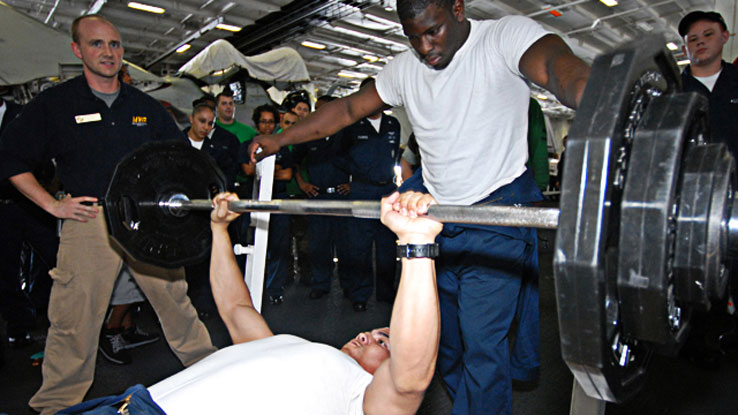Keep getting a stiff neck or upper-back soreness? There's a good chance the culprit is your shoulders. If either your shoulder joint or your shoulder blades (scapulae) lack range of motion, stability, or control, then you'll overload other muscles to compensate. The result is often neck pain.
Fortunately, there are some simple tests you can do at home that'll help you pinpoint the solution.
First let's look at shoulder joint range of motion (ROM). By "shoulder joint" I mean the ball and socket only. The ball is at the top of the upper arm and sits on a very shallow socket that's basically the top corner of the shoulder blade.
If you lose movement at this joint, your shoulder blade (scapula) will need to move more than it should to compensate. This is what will often defer muscular pain into the neck as a result.
Shoulder rotation is how far your upper arm can rotate on the socket. It's often limited in people who don't even realize it. Rotation is important because while your arm is doing the big movements, like pressing and pulling, there's rotation happening at the joint.
There are two tests for this. It's important to test properly and not get caught up in trying to pass either. You'd only be cheating yourself. Your shoulder blades must stay still. If they move, that means you're moving the socket. That also means you won't be testing what movement there is between the ball and the socket since the socket is moving too.
- Lie on your back with your upper arms out to your sides at shoulder level. Your fingertips should all be pointing up to the sky and your elbows should be bent at 90 degrees.
- Keep your shoulder blades STILL as you rotate your arms up overhead as far as you can, externally rotating the shoulder joint. You should be able to reach the floor with your forearms flat without your shoulder blades moving.
- Now reset. Go back to the starting position and repeat the test but turn your arms downward toward the floor. You want to get to 70 degrees internal rotation, minimum. That's 70 degrees before you run out of shoulder rotation and the shoulder blade moves.
Measuring that is tricky, but in simple terms you need to be getting three quarters of the way down to the ground from the start point, as a minimum, without needing to move your shoulder blades. Remember, cheating or kidding yourself isn't helping.
Now lie on your side and repeat the test with the same parameters. You'll need to address and improve whichever ranges are limited.
The Solution
PNF stretching will help and it looks a lot like the positions you were just in. It allows you to address the position you need and activates the stabilizers at the new end ranges so it improves strength and stability.
During your warm-ups, lie in whatever position in which you had limited rotation (if there's more than one, work through them in turn) and gently hold the limited end range for ten seconds.
Then isometrically activate the problem muscles as hard as you can against resistance from the other hand for ten seconds. At the end of the activation, ease off and you'll get a drop from the arm – an increase in range of motion.
Repeat for another two or three rounds, tops. Finish with an activation so you enter your sessions with both improved ranges of motion and improved activation at the end range. Doing so will give you stability and reduce the risk of injury during your workouts.
Now that we know what to do with your shoulder joint, let's look at the shoulder blades.
Your shoulder blades should sit fairly smoothly against your rib cage and glide around against it. That gliding points your shoulder socket in the general direction you want your arm to go. It gives you about a third of the total movement of the upper arm, with the other two-thirds coming out of the shoulder joint itself.
Having established how to get the shoulder joint freed up – if that was the issue – you'll still need to check and see if the shoulder blade itself can move how you want it to.
Set up your camera to film yourself because you might not be able to feel what you can see.
- Get on all fours.
- Draw your shoulder blades back and together, while still flat against your ribcage.
- Then glide them apart and spread them as far as they'll go. Now, can you do both without your shoulder blades uncontrollably shrugging up towards your ears or "winging" away from your ribcage and sticking up toward the ceiling? If you can, move forward to the next stage.
- This time draw your shoulder blades together. Shrug them up and then depress them back down all while still pulled together.
- Then spread them apart and shrug and depress them again, keeping them spread.
The Solution
Essentially, whatever you can't do and whatever you can't control, you must practice and teach yourself to do. Add it to warm-ups. You might need to review the video you took of yourself doing it to know what you need to work on.
In addition to working to control the scapula movement in the quadruped position without load, try these loaded exercises. They'll help you test which ranges of movement you find scapula control difficult.
Scapula Pull-Up
Overhead Dumbbell Shrug (Seated)
Seated Dumbbell Shrug
Remember to keep the scapulae retracted and flat against rib cage.
Scapula Dip
Scapula Push-Up
Scapula Row
You'll find that the ranges in which you struggle to control and stabilize your scapulae correlate with problem exercises. If that's the case, then add the scapula movement right after your warm-ups.
If you're unstable in overhead shrugs, do the movement before you overhead press to activate the scapula stabilizers. But don't make the mistake of getting too carried away and chewing up time with this. Test each range periodically and make sure they're okay, but only spend time on the ones that need it.
Give your attention to the ones where there's a big asymmetry or lack of control. A little asymmetry is normal and fine; you'll even see it in my videos.
In addition to reducing or eliminating neck pain, improving your shoulder mobility, scapula range of motion and control will also give you a better platform for ALL upper-body pressing and pulling movements. So it's well worth the investment.
Note: If you have neck pain that shoots down your arms, makes you nauseous, gives you blurry vision, or pretty much anything other than localized muscular soreness, skip these drills and see your doctor.





